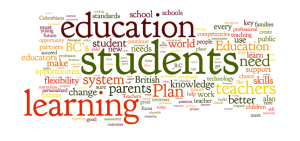#tiegrad was lucky to have a late night chat with Dave Cormier. He was passionate about the ideas he shared and gave us a lot to think about. He began by sharing his thoughts on rhizomatic learning and equating it to invasive plant species. His explanation and his blog post helped me to have a better understanding of this. I have heard this term, and have had it explained a few times, but I didn’t have the connections needed to truly understand it until I looked at the ivy in my side yard. It is successful in taking over new places and popping up unexpectedly. It has no beginning or end, just like the learning process – as Dave states in his blogs.
What really stuck with a few of us is Dave’s explanation of his assessment practices. He speaks of an “open syllabus” in his blog post and shared a copy of his syllabus during our meeting. The importance of the open syllabus is that it allows learners to find their own paths and language of the learning process. To assess learners as they navigate these varied paths, Dave only assesses their effort. He asks his students to view the syllabus as a learning contract where they are required to participate in learning and reflection. Dave describes the lecturer as the “content expert”, but acknowledges that the learner is the one who decides what they would like to get out of participating in the course. The syllabus outlines what success looks like, and sets the tone for life-long, self-valued learning.
Negotiated assessment is an excellent goal. I try to use it in my own practice with my Middle School students. I give them a similar template to the report card that they will receive and ask them to provide feedback on whichever parts they would like. Some students assign letter grades, others reflect on their learning in words. Some provide feedback in all subject areas, others prefer to report only on areas of strength. I give them the same report card and ask for feedback on the same areas again, but this time with the focus on my teaching. Some students complete this form anonymously, others attach their names.
But, there are issues with self-assessment. I saw it with my own completion of the self-evaluation we were asked to do for our EDCI 569 course. I hesitated until the last possible minute to hand in the feedback. I struggled with the same things that some of my students do: self-doubt, honesty, humility, and comparison. Even when given a rubric (like the Masters level grading scale) it is difficult to assess your place on it without comparing yourself to other learners, past and present. And, comparing yourself to your best days and your worst times. Where do you fit in on that scale?
My highest achieving students regularly rate themselves lower than they should because they have become overly effective critical thinkers and as such, they over-think the reflective process. They would always like more time to polish their products, because they truly know learning is ongoing.
Self-evaluation is something that needs to be scaffolded for learners. There should be choice and dialogue built in and assigning numbers or grades should be optional. Maybe even the format of the self-assessment should be fluid, so that learners could customize the method of reporting? With tools such as Google Docs available, the teacher could list the outcomes of the project/unit of study/term and provide some structure for self-evaluation with the invitation to edit the evaluation as desired. If we are speaking of assessing effort, as Dave suggests, we need to also realize that the process a learner undergoes in reflecting upon their effort may vary. If you assess effort as part of your practice, please share your methods below.
I loved learning about Melody Watson’s assessment approach in her school, where the parents, teachers and students sit down together to complete the reporting process.
https://twitter.com/melodylwatson/status/575501746484551680
I imagine that this process would take a great deal of time, but having all voices present for this reflective time would provide a wealth of information. Parents would be able to provide more context for the discussions and time spent on informal learning beyond the classroom walls and the student would be given an opportunity to share their thoughts on their learning process. This dialogue can be extended through the use of digital portfolios – something that Melody already does with her learners. The portfolios allow all parties (parents, student and teachers) to comment on uploaded artifacts of learning. This would ensure that the meetings are focused and that nothing comes as a surprise to any of the participants.
Things are moving in a wonderful direction in education: honouring student interests, inquiry-based learning, and authentic assessment. It will be messy finding our way; but we are so lucky to be doing this in a time when sharing our practice, being transparent with our efforts (both the successes and the failures) are a part of the collective journey.

